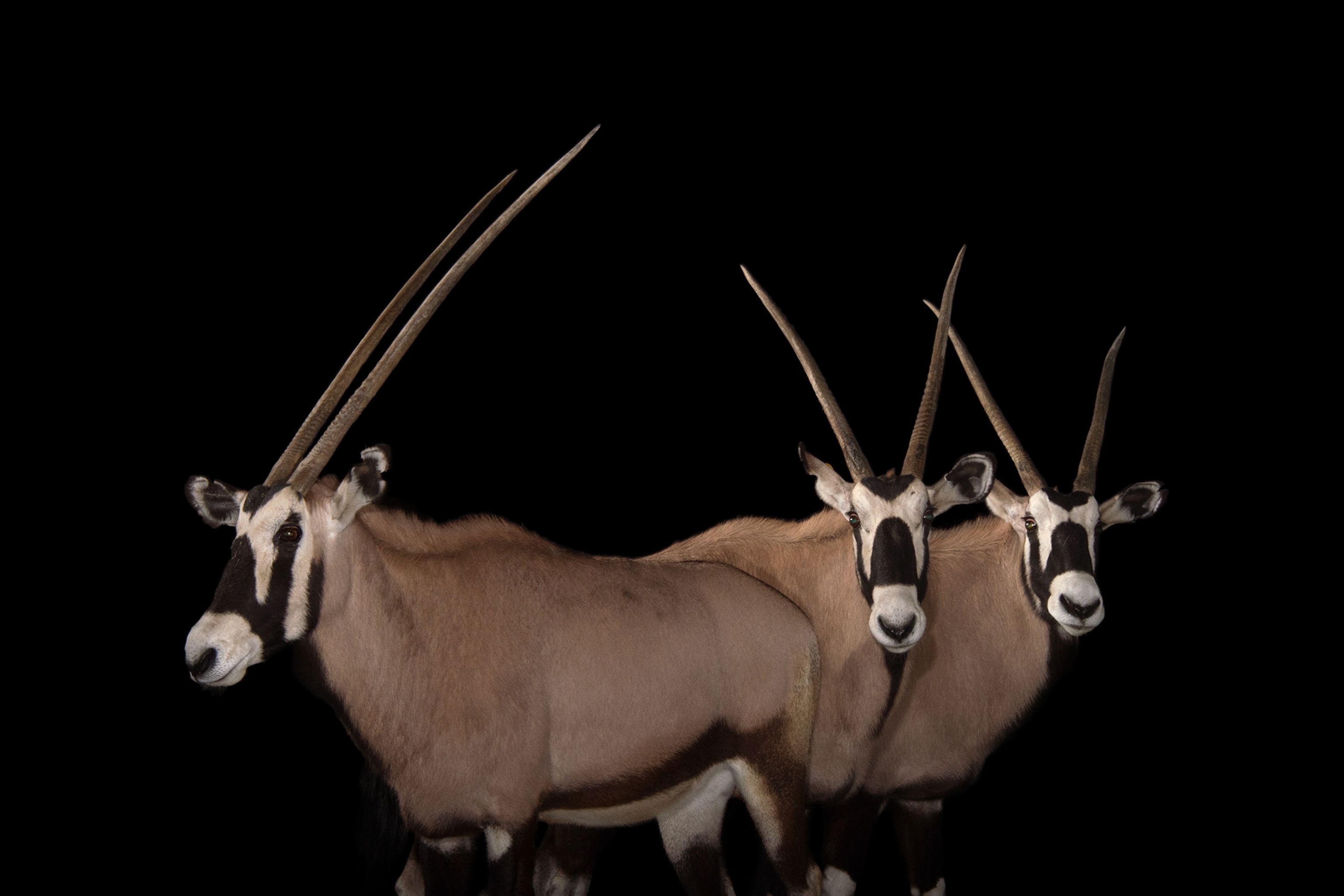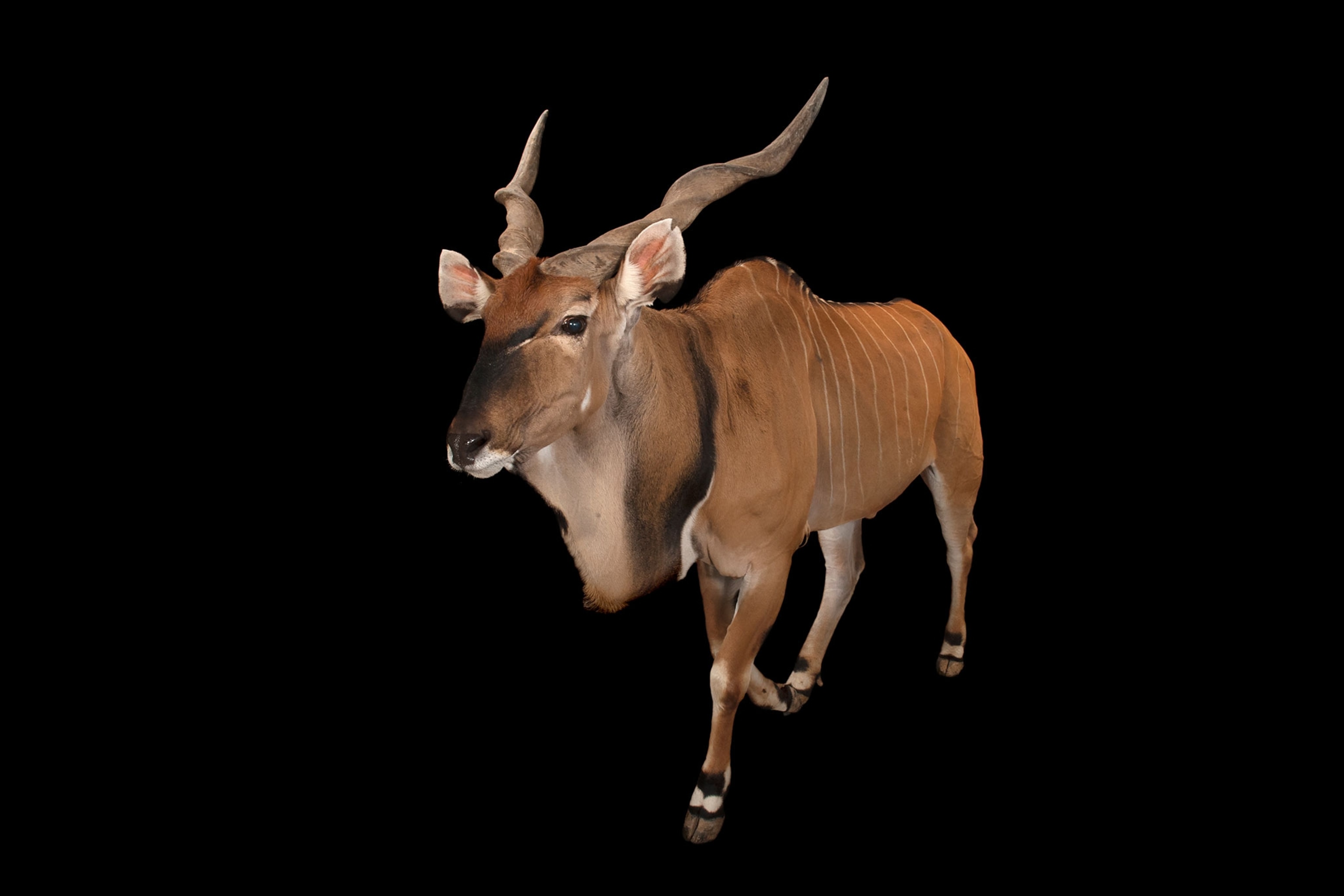
Choose your weapon: How animals got their tusks, horns, and antlers
Location and lifestyle seem to sway whether a species evolves mouth weapons, like tusks, or head weapons, like antlers and horns.
The animal kingdom is a dangerous place, full of claws, jaws, stingers, and spines. But when it comes to home-grown weapons, perhaps no collection of animals is as heavily armed as the artiodactyls.
Also known as even-toed ungulates, artiodactyls include everything from llamas and camels to deer, cattle, and goats. And many of these species sport large, powerful armaments such as tusks (elongated teeth), antlers (temporary bone growths), and horns (permanent keratin structures). (See the muntjac and other "fanged deer")
People have been fascinated by these weapons for thousands of years, but scientists still aren’t quite sure why such closely-related animals would evolve so many different strategies for doing damage.
Now, a new study published in the Journal of Mammalian Evolution has zeroed in on what appears to be a crucial factor for whether an animal will develop tusks, antlers, or horns: location, location, location.






















By analyzing canine tooth length in 63 artiodactyl species and comparing them to the lifestyles of the animals they belonged to, scientists found that the smaller the animals evolved to be, the larger and longer their tusks seemed to grow. Likewise, species that slowly evolved to be larger seemed to abandon their mouth weapons over time, often in favor of head weapons such as antlers and horns.
Interestingly, there was also a connection between tusk size and animals’ social structure, in which species that started hanging out in larger groups saw a reduction the size of in their mouth weapons. Likewise, more solitary creatures retained the slashing, stabbing teeth.
But why should size or sociality matter for weaponry? Well, it makes sense when you consider that the loner artiodactyls tend to live in closed habitats such as dense rainforests, while the larger, more social artiodactyls often inhabit more open areas.
“If you’re going to suddenly meet someone in a dark, closed alleyway, you don’t want to fight with a broadsword,” says Theodore Stankowich, a biologist at the University of California, Long Beach and senior author of the study.
“You want to fight with a dagger.”
Billboards that can kill
It’s partly common sense why animals wouldn’t evolve large head adornments if they live in thick vegetation. One wrong move and the animal could become entangled in such a way that they starve or are left vulnerable to predators.
But there’s another reason why more open environments would favor large, easily visible head adornments, says Doreen Cabrera, a behavioral ecologist at Brigham Young University and lead author of the new study.
In a word, advertising.
“Horns and antlers can signal strength from afar,” says Cabrera.
Fights are costly affairs, after all. Not only does sparring eat up tons of energy, but every battle puts an animal at risk of injury, which could affect its ability to compete for females or even survive.

So if a male ram or elk can intimidate a rival with looks alone, all the better.
Likewise, signaling would probably be much less effective in a closed environment, such as a thick forest, because animals can’t see each other across long distances.
Misfit muntjacs
While the new study provides new insight into the study of weapon evolution, loads of questions remain. For instance, what of the muntjacs, small deer native to Asia that have evolved both antlers and tusks?
A number of deer species have vestigial canine teeth, says Stankowich—in other words, elongated canines that no longer serve as weapons. But muntjacs seem to use both their head and mouth weapons when they duel.
“They have a fighting style where they will fence a bit with their antlers and try to flip their opponent’s head up and then come in and slash their opponent with the tusks,” says Stankowich.
It’s possible that muntjacs simply represent an intermediary stage between artiodactyls with antlers and those with tusks. Their antlers are short, their tusks are long, they are reasonably large in body size, and their habitat isn’t completely open or closed.
“They sort of live on this margin where they’re sort of half true deer, and half forest-dwelling slinkers,” says Stankowich. “Muntjacs are a puzzle.”
“Unanswered questions”
Muntjacs aren’t the only outliers, by the way.

Hippos are also artiodactyls, but ones that ballooned to enormous proportions. Despite their heft, the animals evolved in the direction of gigantic, lethal tusks instead of antlers or horns, as might be predicted by their body size. Perhaps this is because the animals spend so much time in water, where head ornaments would create drag.
Babirusas, or deer-pigs, are another oddity. While these animals retained a set of tusks for fighting, they also evolved another set that sprouts out the middle of their faces, which seems to act like a facemask protecting them from incoming attacks.
“These traits have fascinated us for a really long time,” says Erin McCullough, an evolutionary biologist who studies animal weapons at Syracuse University and was not involved in the study. “But I think there are still a lot of unanswered questions about why different species have different types of weapons or why do some species not have weapons at all.”
For instance, there is plenty of competition among male birds, yet we don’t see any antlers or horns, says McCullough. Instead, birds tend to evolve elaborate looks and behaviors, as famously seen in birds of paradise.
Similarly, McCullough wonders whether for artiodactyls, a solitary lifestyle or a closed environment is more important for evolving tusks as opposed to antlers, if indeed that’s what has happened.
“It’s a cool idea,” she says, “but there’s still a lot of work that needs to be done to try and figure out the diversity of these traits.”
You May Also Like
Go Further
Animals
- This ‘saber-toothed’ salmon wasn’t quite what we thoughtThis ‘saber-toothed’ salmon wasn’t quite what we thought
- Why this rhino-zebra friendship makes perfect senseWhy this rhino-zebra friendship makes perfect sense
- When did bioluminescence evolve? It’s older than we thought.When did bioluminescence evolve? It’s older than we thought.
- Soy, skim … spider. Are any of these technically milk?Soy, skim … spider. Are any of these technically milk?
- This pristine piece of the Amazon shows nature’s resilienceThis pristine piece of the Amazon shows nature’s resilience
Environment
- This pristine piece of the Amazon shows nature’s resilienceThis pristine piece of the Amazon shows nature’s resilience
- Listen to 30 years of climate change transformed into haunting musicListen to 30 years of climate change transformed into haunting music
- This ancient society tried to stop El Niño—with child sacrificeThis ancient society tried to stop El Niño—with child sacrifice
- U.S. plans to clean its drinking water. What does that mean?U.S. plans to clean its drinking water. What does that mean?
History & Culture
- Séances at the White House? Why these first ladies turned to the occultSéances at the White House? Why these first ladies turned to the occult
- Gambling is everywhere now. When is that a problem?Gambling is everywhere now. When is that a problem?
- Beauty is pain—at least it was in 17th-century SpainBeauty is pain—at least it was in 17th-century Spain
- The real spies who inspired ‘The Ministry of Ungentlemanly Warfare’The real spies who inspired ‘The Ministry of Ungentlemanly Warfare’
- Heard of Zoroastrianism? The religion still has fervent followersHeard of Zoroastrianism? The religion still has fervent followers
Science
- Here's how astronomers found one of the rarest phenomenons in spaceHere's how astronomers found one of the rarest phenomenons in space
- Not an extrovert or introvert? There’s a word for that.Not an extrovert or introvert? There’s a word for that.
- NASA has a plan to clean up space junk—but is going green enough?NASA has a plan to clean up space junk—but is going green enough?
- Soy, skim … spider. Are any of these technically milk?Soy, skim … spider. Are any of these technically milk?
- Can aspirin help protect against colorectal cancers?Can aspirin help protect against colorectal cancers?
Travel
- What it's like to hike the Camino del Mayab in MexicoWhat it's like to hike the Camino del Mayab in Mexico
- Follow in the footsteps of Robin Hood in Sherwood ForestFollow in the footsteps of Robin Hood in Sherwood Forest
- This chef is taking Indian cuisine in a bold new directionThis chef is taking Indian cuisine in a bold new direction
- On the path of Latin America's greatest wildlife migrationOn the path of Latin America's greatest wildlife migration
- Everything you need to know about Everglades National ParkEverything you need to know about Everglades National Park







